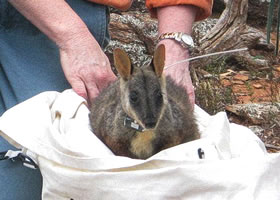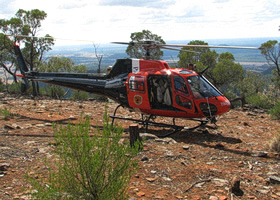Pulling rock-wallabies from an extinction vortex!
In 2008, WWF-Australia in partnership with the NSW Department of Environment and Climate Change received funding from the Australian Government’s Caring for our Country program for a project entitled ‘Pulling rock-wallabies from an extinction vortex.’
 Photo: Ryan Collins
Photo: Ryan CollinsWWF consider the Brush-tailed Rock-wallaby (Petrogale penicillata) to be a ‘Global Flagship Species’ along with other threatened macropods. The species has received intensive management attention for well over a decade, yet continues to decline. Numerous populations of Brush-tailed Rock-wallabies in NSW are currently so low that, even with the targeted threat abatement currently employed, juvenile recruitment is incapable of compensating for occasional mortality from feral and native predators. This results in an extinction vortex where colony sites are gradually blinking out across the landscape.
This project involved radical, immediate action by supplementing weak colonies to pull them out of this ‘predator pit’, and stabilise numbers at a level high enough to tolerate occasional predation. This project comprised three phases:
- Assess: determine colony size and sex ratio through survey and DNA analysis, identify limiting factors and develop site management plans;
- Release: conduct targeted threat abatement and release radio-collared rock-wallabies;
- Monitor: determine establishment of a viable colony and maintain threat abatement at suitable levels.
 Photo: Ryan Collins
Photo: Ryan CollinsAdditionally, the project aimed to improve knowledge and involvement of community groups and landholders in recovery actions for Brush-tailed Rock-wallabies via – training and employing volunteers to assist staff members; communication of results; developing information to provide management guidelines for landholders; and promoting and raising awareness of Brush-tailed Rock-wallabies.
The project brought together non-government organisations (such as WWF and Waterfall Springs Wildlife Sanctuary) and government partners with the necessary skills and expertise to deliver a multi-faceted recovery project for Brush-tailed Rock-wallabies.
State Information
What you can do!
An important aspect of Brush-tailed Rock-wallaby recovery is the active involvement of local landholders and the community overall. See what you can do!
Resources
- Vortex Project Brief
- The Shadow – Newsletter of Brush-tailed Rock-wallaby conservation in Victoria
Did you know?
Rock-wallabies aren’t found anywhere else on earth. There are 16 species of rock-wallaby and they form the largest group of macropods (marsupial with large hind limbs) in Australia.






